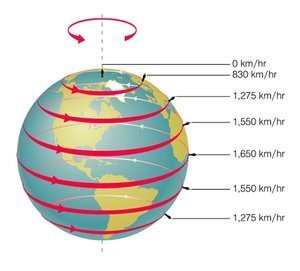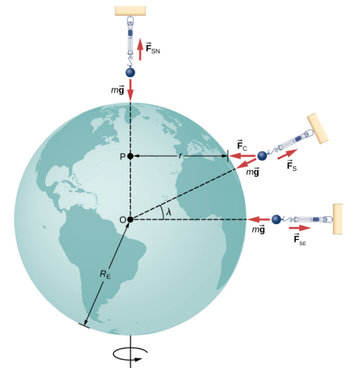Apparent vs. True Weight - The Physics
When was the last time you weighed yourself? Was the figure what you had expected? If not, then there could be some good news: the numbers do lie. Unless you live at a Pole (all will be revealed), your household scales haven’t been giving an entirely accurate reading.
Rather than a testament to the quality of homeware endemic only to the Arctic Circle, the secret as to why you may be able to take that reading with a pinch of salt lies in the way in which most scales work. The most rudimentary scales use springs to support a mass, and although most of us now use more advanced scales, they still use the same principle; the springs exert an upward tensile force equal and opposite to the Earth-ward force of attraction.
The reading given by the scales is calculated using this tension force - as far as the device is concerned, the downward force, to which the tension is equal and opposite, comprises solely your weight (your gravitational attraction towards the Earth’s centre of mass - we’ll call this attraction your true weight).
Remember, reading your ‘weight’ from the scales is actually a misnomer; the displayed figure is a calculation of your mass using the relationship between your apparent weight (a force which would be presented in Newtons and is around 10 times greater in magnitude) and gravitational acceleration.
Intrepid weight-conscious adventurers reading this after a hard day with the crampons: this is bad news. At either Pole, the Earth is not rotating as it is everywhere else. This means that the assumption on which scales operate is correct – the Pole is an inertial frame of reference, in which the idea that a body in equilibrium experiences no net force and thus no acceleration as per Newton’s 1st Law – and an accurate reading is given.
Indeed, an explorer stood at the North Pole is not accelerating; while they are hurtling through space at an average speed of 67,000 miles per hour just like the rest of us, their velocity is, for this discussion, considered constant. A body with zero acceleration experiences no net force, meaning the upward tension maintaining equilibrium really is equal to the magnitude of your true weight.

However, moving away from the pole, a crucial phenomenon is in play: the rotation of the Earth about its axis. At any distance from the North or South Pole, we move about this axis as the ground does below us. This means that the weighee, along with their set of scales, is no longer considered an inertial frame of reference – clearly both are moving in a constantly changing direction (rotating) and this constitutes acceleration.
An accelerating body is doing so because it is acted upon by a causal net force, and the resulting acceleration about the Earth’s centre is termed centripetal acceleration. A net force towards the Earth’s centre must mean that the upward force of the spring tension (which represents the force used by the scales to calculate mass/'weight' in kilograms) is not equal to but lesser in magnitude than the downward force due to gravitational attraction. The difference between these two values is the centripetal force.
We have stumbled across the bad news: true weight is actually greater than apparent weight. At distances further from the poles, the Earth’s surface spins (accelerates) more quickly, meaning that the centripetal (net inward) force – the discrepancy between true and apparent weights – is greater, and at its greatest at the equator. The diagram below shows that bodies closer to the equator not only have greater acceleration and net inward force, but a greater component of their centripetal force acting parallel to the weight of the object. This further increases the difference between the bodies’ true and apparent weights.

So we are all in fact ‘heavier’ than our scales suggest, but what does this really mean? Have you been horrifyingly overweight all along?
In short, no. The calculated difference between true and apparent masses even at the equator is small – around 250 g, or 9 Oz, for the average male adult – and many modern scales use technology that accounts for the Earth’s acceleration.
So while your diet is never going quite as well as you think, you can take the scales’ word for it (on planet Earth, anyway).
References:
http://wonderfulengineering.com/will-see-ground-stationary-air/
https://goo.gl/FWW2wn
Nice and very informative article my friend.... Thank You for sharing....
Thank you - more to come!
This gem of a post was discovered by the OCD Team!
Reply to this comment if you accept, and are willing to let us promote your gem of a post!
If you accept this, you'll be nominated and the members of the OCD team will vote on whether we'll feature your post in our next compilation post.
You can follow @ocd – learn more about the project and see other Gems! We strive for transparency.
I'm mostly curating in #science and am always glad to see quality posts like yours peeking out between the garbage and plagiarism!
Hi, thanks for the kind words - I'd love to be nominated for your next compilation post. Hopefully my posts will only improve!
Great :) I'll nominate you for Tuesday
Congratulations @cjrc97! You have completed some achievement on Steemit and have been rewarded with new badge(s) :
Click on any badge to view your own Board of Honor on SteemitBoard.
For more information about SteemitBoard, click here
If you no longer want to receive notifications, reply to this comment with the word
STOPi knew that $12.99 wal-mart scale was full of crap! found you via @OCD
Glad to hear you've enjoyed reading a few of my articles and you spotted me on @OCD!